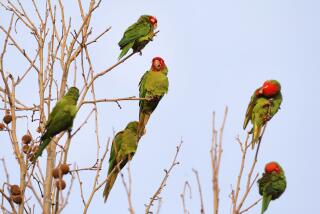Vaux’s swifts are bunking in a downtown L.A. chimney
- Share via
Two dozen naturalists gathered on the roof of a downtown Los Angeles parking structure at sundown Friday to witness an unusual spectacle: tens of thousands of migrating birds spiraling into an abandoned brick chimney for the night.
The aerial display began when Vaux’s swifts — 4 ½-inch birds with cigar-shaped bodies and long, crescent-shaped wings — began heading in from all directions, swirling around the chimney of the adjacent 12-story, 84-year-old Chester Building.
The odd locale is believed to be one of the most populous roosting sites for the birds in North America, local avian experts said.
Vaux’s swifts began seeking evening accommodations in the Chester Building about a week ago, according to parking structure attendant Tomas Hernandez. “I never dreamed I’d see something like this in the central city,” he said.
The birds probably are in the peak of their northward migration from wintering areas in Mexico to breeding grounds as far north as Oregon, Washington, southeastern British Columbia and Alaska, according to Kimball Garrett, ornithology collections manager at the Natural History Museum of Los Angeles County.
“That chimney is a good place for them to sleep,” he said. “They spend all day feeding on nice hatches of insects blown skyward by updrafts along the Los Angeles River and Elysian Park area. At nightfall, they all come together to roost in the same safe resting area.”
About 7:20 p.m., the birds began funneling down the chimney. Hungry ravens were waiting for them, using their beaks to snag birds out of the air as they plunged into the chute.
The swift watchers peering through binoculars were not happy about that.
“It’s like watching bears grab salmon out of a river — where’s the 12-gauge shotgun?” lamented Los Angeles Audubon spokeswoman Mary Locuvam.
“No way! Ravens have to eat too,” Nicole Possert responded with a laugh.
Then there was 2-year-old Avery Van Gundy, who couldn’t take her eyes off the chaotic waves of birds overhead. “There’s a lot of birds, Mommy,” she said, snapping photographs with a camera she learned to use a few days ago.
Chaetura vauxi generally spends most its time in flight, foraging on high-flying insects and baby spiders. It pauses at sundown to seek refuge and protection in the hollow trees of old-growth forests — or the next closest thing, brick chimneys.
Smooth insulated pipes, which have been used instead of seismically questionable brick chimneys since the 1940s, won’t do. The Vaux’s swifts can’t grab the smooth surfaces with their tiny feet and sharp claws, and prefer the brick and mortar. As old chimneys deteriorate or get torn down, the birds are running out of roosting sites during their annual migrations.
But the chimney is only a temporary migratory stopover, said Charlie Collins, a retired Cal State Long Beach biology professor and expert on swifts around the world. “They’ll be gone within a week or two. But they’ll be back at the same chimney during fall migration in September. I’d bet on it.”
No one can say with certainty why the birds adopted the Chester Building’s chimney. Audubon Society officials believe the birds, one of the largest colonies of migrating Vaux’s swifts in North America, have been moving from one torn-down chimney to another over the last 20 years.
Anecdotal evidence suggests their former roosting sites included L.A.’s seven-story Nabisco Biscuit Co. building and a structure in downtown Long Beach. The Chester Building “may be one of the most significant pieces of local habitat this species has right now,” said Larry Schwitters, head of the Audubon Society’s Vaux’s Happening project, which tracks the birds.
“In the heart of one of the world’s great steel-and-asphalt jungles, a great wildlife migration is underway,” Schwitters, of Issaquah, Wash., said in a telephone interview. “Sites with more than 10,000 Vaux’s swifts are very rare. There are only about six of them in the world.”
As the birds poured down the chimney, Gary George, chapter network director of Audubon California, shook his head, smiled and marveled: “Just look at them.”







